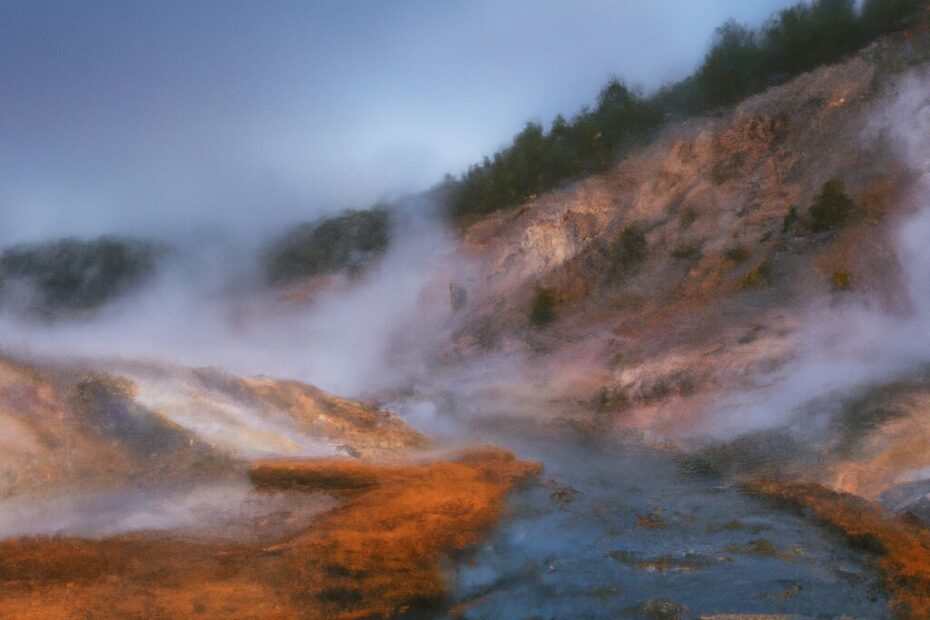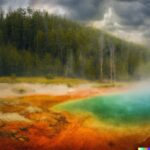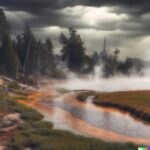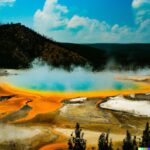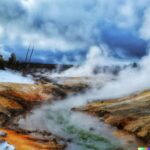Yellowstone National Park is home to some of the most spectacular geysers in the world. But do you know when and how these natural wonders were discovered? Join us as we explore the fascinating history of geysers in Yellowstone, from their initial discovery to their impact on the surrounding area.
We will also take a closer look at some of the famous geysers in the park, how they form, and why they are only found in certain areas. We will delve into the cultural significance of these geysers, from Native American legends to their role in tourism.
So, grab your virtual hiking boots and let’s embark on a journey to uncover the secrets of Yellowstone’s geysers.
What Are Geysers?
Geysers are natural wonders that form part of the geothermal features found in Yellowstone, showcasing the area’s unique hydrothermal system and geological marvels.
These mesmerizing geothermal phenomena are created by the interaction of groundwater with the searing heat from the Earth’s mantle, causing underground water to reach boiling temperatures and turbulent pressure. The build-up of pressure inside narrow passages leads to the dramatic eruptions that characterize geysers, with steam and water violently expelled into the air.
Yellowstone National Park’s hydrothermal system is crucial in sustaining these geysers, providing a glimpse into the Earth’s raw power and the intricate balance of forces beneath the surface. As one explores the park, the array of bubbling hot springs and erupting geysers stand as a testament to the region’s geothermal hotspots and the constant geologic activity at play.”
When Were Geysers Discovered in Yellowstone?
The discovery of geysers in Yellowstone dates back to a significant period in the region’s geologic history, leading to extensive research and exploration of the area’s unique geothermal formations.
These geysers were first encountered by European explorers in the early 19th century, sparking curiosity and scientific interest in understanding the underlying geological processes that created these impressive natural wonders.
Yellowstone’s geysers are a product of the volcanic activity occurring deep beneath the surface, where heated water and steam build up pressure until they erupt in spectacular displays. Over time, researchers have conducted detailed studies to map the hydrothermal features of the park, delving into the intricate network of underground thermal sources that power these geysers.”
Who Discovered the Geysers in Yellowstone?
The geysers in Yellowstone were first officially discovered during a scientific study and geothermal exploration of the park, revealing the extraordinary natural phenomena present in the area.
Researchers and explorers, fascinated by the unique landscape of Yellowstone National Park, embarked on a journey to understand the geothermal wonders hidden beneath its surface. It was in the 19th century when members of the Washburn-Langford-Doane Expedition first documented the geysers, bringing attention to these natural marvels.
Their findings paved the way for further scientific investigations into the geological processes that create and sustain these spectacular hydrothermal features. Through their pioneering efforts, the beauty and significance of Yellowstone’s geysers were established, capturing the imagination of future generations of scientists and visitors.
How Did the Discovery of Geysers in Yellowstone Affect the Area?
The discovery of geysers in Yellowstone had a profound impact on the area, shedding light on its volcanic origins, enhancing the understanding of geothermal activity, and showcasing the diverse geothermal features shaped by intricate geologic processes.
This remarkable discovery not only unveiled the hidden volcanic nature of Yellowstone but also broadened our comprehension of how geothermal systems operate within the Earth’s crust.
By studying these geysers, scientists were able to delve into the intricate mechanisms behind the formation of hot springs, mud pots, and fumaroles, each representing a unique outcome of the geological forces at play.
Through this exploration, researchers gained a deeper appreciation for the dynamic Earth processes that have sculpted Yellowstone’s awe-inspiring landscapes over millennia.
Famous Geysers in Yellowstone
Yellowstone is renowned for its famous geysers, with attractions like Old Faithful captivating visitors with its spectacular eruptions and the surrounding geological formations of the geyser basin highlighting the area’s rich geothermal reservoir.
The eruption of Old Faithful, which occurs approximately every 90 minutes, often reaching heights of around 130 feet, is a mesmerizing sight that draws in crowds of onlookers. Not only does Old Faithful showcase the power of Yellowstone’s geothermal activity, but it also serves as a reminder of the unique geological processes that have shaped the landscape over millions of years. The geothermal reservoir beneath Yellowstone National Park is a vital component in sustaining these natural wonders, providing the heat and pressure necessary for the geysers to erupt.
Old Faithful
Old Faithful stands as an iconic geyser in Yellowstone, renowned for its predictable eruptions and the surrounding geological formations that showcase the area’s abundance of hot springs and geothermal energy.
Visitors flock to witness this natural wonder erupt with steam and water shooting up to 185 feet into the air at regular intervals. The geyser, along with the nearby thermal features like the Grand Prismatic Spring and the Mammoth Hot Springs, highlights the geological activity underlying the park. Yellowstone’s unique ecosystem thrives on these geothermal resources, with some areas harnessing the power of underground heat for sustainable energy production. The synergy between nature’s power and human innovation creates a harmonious balance in this remarkable landscape.
Steamboat Geyser
Steamboat Geyser, one of the impressive geysers in Yellowstone, showcases the dynamic geologic processes at work, with its powerful eruptions releasing steam vents and depositing sulfur in the surrounding areas.
Its eruptions are a spectacle to witness as they can reach heights of over 300 feet, making it the world’s tallest active geyser. The geothermal activity beneath the geyser creates immense pressure, leading to these sporadic but powerful eruptions. The release of steam vents during these eruptions not only captivates visitors but also plays a crucial role in regulating the geyser’s internal pressure. The deposition of sulfur in the vicinity adds to the otherworldly beauty of the landscape, with its vibrant hues contrasting against the surrounding geothermal features.
Grand Geyser
Grand Geyser, a majestic feature in Yellowstone, highlights the significance of groundwater interactions, the formation of thermal pools, and the release of intense geothermal heat, captivating visitors with its grandeur and natural beauty.
As one stands in awe of Grand Geyser’s towering eruptions, it’s fascinating to note how the interaction between the heated groundwater below and the surface creates the perfect conditions for these spectacles. The thermal pools surrounding the geyser are a testament to this ongoing geothermal activity, reflecting the colors of the minerals and microorganisms present. The intense geothermal heat that accompanies these eruptions adds to the mystique of Grand Geyser, attracting both scientists and nature enthusiasts keen to witness the Earth’s power in action.
How Do Geysers Form?
The formation of geysers involves intricate geologic processes driven by geothermal heat, which interacts with the underground geothermal reservoirs, resulting in the remarkable hydrothermal activity that leads to geyser eruptions.
As geothermal heat from Earth’s core rises through the crust, it warms up underground water stored in porous rock formations. This heated water creates a geothermal reservoir, a crucial component in sustaining geyser activity. Pressure builds within these reservoirs, causing the water to rise towards the surface. When the superheated water encounters a constriction in the geyser’s plumbing system, it erupts in a spectacular display of steam and boiling water, marking the distinctive eruptions characteristic of geysers.
The Role of Volcanic Activity
Volcanic activity plays a pivotal role in the formation of geysers in Yellowstone, shaping distinctive geologic formations and creating the underlying geological structures that facilitate the emergence of these hydrothermal features.
The interaction between magma chambers and underground water sources beneath Yellowstone National Park results in a dynamic environment where superheated water and steam are pressurized until they erupt through openings in the earth’s surface with immense force, giving rise to the iconic geysers like Old Faithful. The continuous supply of heat and energy from the volcanic activity sustains the boiling water reservoirs that feed these geysers, contributing to the cyclic nature of their eruptions and the development of the surrounding thermal landscapes.
The Importance of Hot Springs
Hot springs play a vital role in the geyser ecosystem of Yellowstone, representing essential geothermal features that contribute to the area’s geologic wonders and unique hydrothermal landscapes.
These hot springs, with their scalding waters rich in minerals, not only attract visitors but also support a diverse array of microbial life specialized to thrive in extreme conditions. The symbiotic relationship between the heat-loving microorganisms and the hot springs creates vibrant colors and intricate patterns that define the mesmerizing geothermal features of Yellowstone.
Through their constant flow and interaction with the surrounding rocks, hot springs sculpt the terrain, forming terraces, pools, and cascades, making them a captivating aspect of the region’s natural beauty.
Why Are Geysers Only Found in Certain Areas?
The presence of geysers is limited to specific areas due to the unique geothermal conditions, geological formations, and the prevalence of geothermal waters that create suitable environments for the formation and sustenance of these natural phenomena.
Geysers are typically found near tectonic plate boundaries, where the Earth’s crust is thinner, allowing heat from the mantle to rise closer to the surface. This heat generates the necessary temperature and pressure for water to boil and build up underground, leading to the spectacular eruptions we associate with geysers. The containment of geothermal waters in underground reservoirs, such as porous rock formations, contributes to the build-up of pressure required for the explosive release of water and steam typical of geyser activity.
The Cultural Significance of Geysers in Yellowstone
Geysers hold a profound cultural significance in Yellowstone, with Native American legends and beliefs often intertwined with the mystical aura of these geothermal phenomena found in the region.
These geothermal marvels not only captivate visitors with their mesmerizing eruptions but also play a crucial role in the spiritual tapestry of Yellowstone. Native American tribes, such as the Shoshone and Crow, have time-honored stories of how these geysers are linked to the Earth’s energies and spirits. For them, geysers are not just natural wonders but sources of spiritual renewal and connection with the land. This deep-rooted connection adds an extra layer of enchantment to the already awe-inspiring landscapes of Yellowstone, making it a place where nature and culture converge in a harmonious dance.
Native American Legends and Beliefs
Native American legends and beliefs surrounding geysers in Yellowstone reflect the deep reverence for these geologic wonders, blending spiritual narratives with scientific interest in understanding the natural world.
Stories passed down through generations by tribal communities in the Yellowstone region depict geysers as manifestations of powerful spirits and guardians of the land. These legends often describe how the geysers’ eruptions symbolize connections between the Earth and the supernatural realm, fostering a harmonious relationship between humans and nature. The cultural significance of geysers transcends mere physical phenomena, with many believing that these natural features hold mystical powers capable of healing and protection.
The Role of Geysers in Tourism
Geysers play a pivotal role in driving tourism to Yellowstone, attracting visitors with the allure of witnessing geologic marvels and exploring the captivating geothermal landscapes shaped by these natural phenomena.
Their mesmerizing displays of boiling water shooting high into the air, accompanied by rumbling sounds and steam clouds, create a surreal experience for onlookers. The unique combination of water, heat, and pressure underground results in these awe-inspiring eruptions that have become iconic symbols of the park. Tourists from around the world flock to Yellowstone to marvel at the spectacle of Old Faithful and other famous geysers, understanding that these natural wonders offer a glimpse into the powerful forces at work beneath the earth’s surface.
Last Updated on February 7, 2024 by Jon Waraas – Originally Posted: February 7, 2024

I’m Jon Waraas, and I’ve been navigating the online world since 2006. By day, I’m the proud owner of some eCommerce gems, and by night, I’m the voice behind the adventures on Waraas.Com.
My heart, however, belongs to the wild beauty of Yellowstone National Park. I’ve got a collection of websites dedicated to sharing the wonders of this natural masterpiece. Oh, and did I mention? I’m currently building my own cabin inside the ghost town of Gilmore, Idaho – a cabin with tales to tell!
When I’m not immersed in the digital realm, you’ll find me lacing up my boots for a good hike or setting up camp under the star-studded sky.
